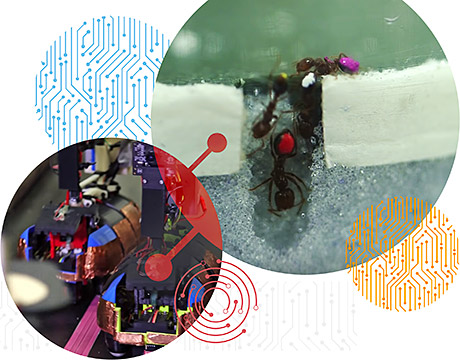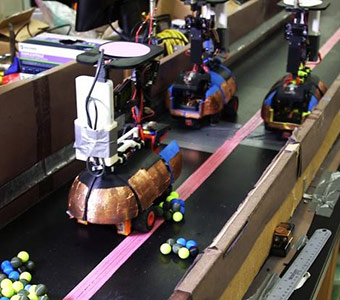|
|
本帖最后由 xz111do 于 2018-11-29 21:24 编辑 0 T5 W% _& V6 |# d4 l* {
. j8 `- y1 S8 G2 A' URobot programmed to work like ants get job downNovember 2018 # ^2 h, J" h( ~3 T o( f3 Y
by Michael Abrams, ASME.org 翻译成中文,参考谷歌翻译,修正 4 r, L7 l5 _0 Q- P' r4 @$ Z
可编程机器人像蚂蚁一样完成工作2 @6 ~& B/ m$ w# a5 s' Q

}/ j$ D- P3 ERobots have long borrowed from nature for locomotion.They fly like bees ,run like cheetahs,bounce like galagos.But as they advance and begain to closely work together on certain tasks,robots have to imitate nature's industrious strategies as well,especially if we want them to perform as efficiently as possible.- e8 q/ ?0 t7 t* R5 |( a" u; z; @
机器人长期从大自然借来运动。他们像蜜蜂一样飞,像猎豹一样跑,像galagos一样弹跳。但是随着他们进化并在某些任务中开始更密切的合作的时候,特别是如果我们想让他们更高效率工作的时候,机器人也必须模仿大自然的勤奋战略。& p/ \3 u$ _+ s* T, D2 e7 c1 G( K& O

5 f1 `1 F$ ~/ IFor instance,a swarm of robots expected to quickly dick a tunnel will need to know the ant method for staying out of each other's way.
) ^0 D& q( w/ ]0 i8 v- |5 v举例来说,一群机器人想要快速挖一个隧道将需要知道蚂蚁的方法是远离彼此的路线。
& k1 r/ m! S- {5 R/ ]) WDaniel Goldman,a professor of physics who runs the Complex Rheology and Biomechanics Lab(or Grab Lab) at the Georgia insitute of Technology
8 K/ b+ H$ h" F. d U6 j: Tnoticed that even though ant tunnels are extremely narrow,they never get choked up with too many workers.% A5 q( _* H( a1 J
Daniel Goldman,一个物理学教授,运营着在格鲁吉亚研究所的复杂流变学和生物力学实验室(或者叫Grab Lab),他观察到即使隧道极为狭窄,他们也从不与太多工作者挤在一起。
8 K7 v d2 a& X! v& A"We wanted to know what they do when they're digging,how they decide how to dig if there's no central leader,"Goldman said.8 ]1 m1 z& u) @$ A
Goldman说“我们想知道当他们在挖掘的时候做了什么,当没有中央领导人的时候他们是怎么决定怎样挖掘的”。5 w+ Z7 u* f- o% C8 u9 Y3 F6 a
For You:Racism Runs Deep,Even Against Robots
0 d, n/ p7 D1 ]; i9 G3 V对你而言:种族注意深入人心,甚至对机器人
9 p9 E5 j6 I2 F" R8 ATo find out,the team get 30 fire ants,put dots of different colors on their abdomens,placed them in a container of wet glass particles,and watched them dig.The team present its results in a recent issue of Science.
% R+ q9 i0 M5 j9 m* o, c5 P$ b为了找出答案,这个团队捉了30只火蚁, 在他们的腹部画上不同颜色的点,把它们放在有着湿玻璃颗粒的容器中,观察他们挖掘。这个小组它研究结果刊登在最近的《科学》的问题中。' j* u! E8 Y0 b0 H1 R1 H
The ants didn't play tag team,work in alternating groups,or take turns in any other fashion.In fact,their strategy is quite simple:A handful of the ants did the work (about 30 percent)while the majority did nothing.
; P, f6 G- c# v. D; k! U蚂蚁没有玩标签团队,工作在可交替的组中,以任何其他方式轮流。实际上,它们的策略相当简单:少数蚂蚁工作(大约百分之三十)然而多数蚂蚁什么也不做。
0 G" n; C1 ?1 c+ ]2 t% F' d. r1 P# f"Very few were doing any of the labor,"Goldman said."Over 48 hours,with a group of thirty ants,half never came to the tunnel."
; Q8 b% A* h- W2 [. J, g“很少的蚂蚁做任何工作”,Goldman说“超过48小时,一个30只蚂蚁的团队,半数没有进隧道。”
; X7 k9 R$ j. X) z7 lWhen his team remove the five hardest working ants,five more stepped up to the plate to carry on the digging.
: b) }& d, f; e/ a( A4 }6 x$ h% }当他的团队移走了五个工作最努力的蚂蚁,另外五只蚂蚁爬到了平台上继续挖掘。
' n! W: S- p1 H2 @; UThe strategy of minority servitude served the ants so well that Goldman decided to try it on a group of robots.+ Z* O% O( b, u. [$ b2 v
少数奴役的策略为蚂蚁很好的服务,于是Goldman决定在一组机器人上尝试这个。+ y: |, k; Y% {9 l
The robots,essentially oblong shells on wheels,resembled armadillos more than ants.Researchers placed them in a narrow channel with plastic valls on4 v; _- f) z' j* o; Z
one end that served as the soil.The robots would roll over to the balls with the intention of grabbing them,moving them,and relasing them with their2 e' n- }# ]% l' t
gator-like jaws.Push switches on their shells would alert them to the presense of their fellow workers.! [. e" ^* P0 n3 x8 D
这些机器人,事实上是轮子上带有椭圆形的壳,类似犰狳而非蚂蚁。研究者们吧它们放在一个狭窄的渠道里,渠道的一端是作为土壤的塑料球。机器人3 k: P( l( Z# M. D g
将翻滚到到球上,通过使用鳄鱼般的下巴有意的抓取他们,移动他们,释放他们。打开它们壳上的开关将提醒他们同时的存在。/ b) O. j, L& |2 m: t
Researchers programmed the bots to follow one of the three strategies for removing the balls:"eager,""reversal,"and"lazy.". \' X- H* r% r* A/ {' K; j" {4 m
研究者们给机器人编程遵循三个策略的其中之一去移走球:“急忙,”“翻转,”和“懒惰。”
! \- N8 T$ s$ R1 Q4 _( LEager robots simply tried go to the dig site as much as possible without interference from their comrades,regardless of how many 4 x* Q/ }$ S$ T. t+ h3 Q |" j
robots were already there.The strategy generated a traffic jams."when we applied a eager strategy,the robots would grind against 1 v- u( V/ G7 s' j. f# w* ?
each other and suffer a lot of breakage,"Goldman said.
s1 e! p e' X T' L急忙的机器人不管来自同伴的干扰而只是尝试去尽可能的挖掘地皮,不管已经有多少机器人在那儿了。这个策略形成了一次交通拥堵。+ Z( i( K: l! J4 C
Goldman说:"当我们应用急忙策略时,机器人会相互反制并且受到了很多破坏。"9 |! |6 F% A- v1 t8 j3 T$ Y# l5 A
Reversal robots would turn around and leave the site if they encountered other workers,but would soon return to try again.Lazy robots
# ?4 L, g* h; q* o' `were largely inactive and would only head to the site to dig occasionly. y/ o7 c1 T; A6 Z( W: y
如果他们遇到了其他工作者的话,翻转机器人将会回转并且离开地皮,但是不久会返回再次尝试。懒惰的机器人大部分不活跃,只会偶尔去挖掘地皮。& y" v, L& b; [/ S9 v8 {
When reversal-minded robots approached the balls and found another robot already at work they would turn around.This proved
* @ t9 s5 D* N4 Z. C& @& V4 Ma relatively efficient scheme with no gridlock,but the work processed slowly.The lazy,ant-imitating robots,however,proved to be the 4 I& d' h+ v8 I- b6 r1 M9 L m
fastest at completing the task.- N& `! ^6 _% I" L
当有翻转思想的机器人接近球并且发现已经有另一个机器人在工作时,他们将回转。这种做法被证明是一种没有堵塞的相当有效的方案,
" ]0 A2 T# D9 o- R但是工作进程慢。那些懒的,模仿蚂蚁的机器人,然而,被证明完成工作是最快的。: ~. B3 p& h" I. s
The strategy could be essential for tommorow's hordes of rescue bots."Future swarm of robots that are moving through a complex* \! `4 y* H z
environment after a nuture disaster,or when a building has collapsed,will be getting in each other's way,"Goldman said."This is a story 3 @. P; W/ |+ D k4 ]
about how to work with uncertainly and unpredictability."+ v# K9 W8 y, I+ c& x
这种策略会对将来的成群的救援机器人有效。“未来在的一群机器人穿越一场自然灾害过后的复杂的环境,或者当一栋倒塌后的大楼,将会; ]9 {0 l# a9 Z- D4 @- f$ C
互相帮助,”Goldman说。“这是一个关于怎样处理不确定性和无法预料性的故事。”
3 s4 q; V$ g% Z9 G! y% ^In the story,robots that talk with each other could take turns or replace robots that lose power or wear out."But then you have to know7 x( }5 I6 C5 l+ f) f | R
what everyone else is doing,"Goldman said.This woud require the technology and programming for higher levers of communication.(As it
! Q# c2 l3 R8 Y) q! l; o2 ehappens,no one knows how ant chose which 30 percent does the work.)But having "lazy",autonomous robot,could keep things lean and ' |4 O* t' q; i6 d |6 m
efficient.
/ v+ F) X2 c* M: v6 ], f+ S在这个故事中,机器人可以互相交流能回转或者替代没有电或者电力不足的机器人。“但是你必须知道所有其他人在干什么,”Goldman说。* i; v3 T' h2 n& D
这样就需要技术和编程更高等级的交流。(当它发生的时候,没人知道蚂蚁是怎样选择哪30个做这个工作。)但是有了“懒的”,自主性机器人,
: Z, x: g' a, @, X, E* ~可以保持精益和高效。
! E' ^9 }9 c; Y/ ^7 R* M6 e6 O" q b+ i8 t# R
) x8 p8 j/ E" C# O" F+ O LMichael Abrams is an independent writer3 C) T* K- Z7 ~
摘自:https://www.asme.org/engineering ... e-ants-get-job-done
. ?( z: n% _7 j* q5 x7 [# Y |
|
|
7 y$ g) v/ g8 V h0 H |
|